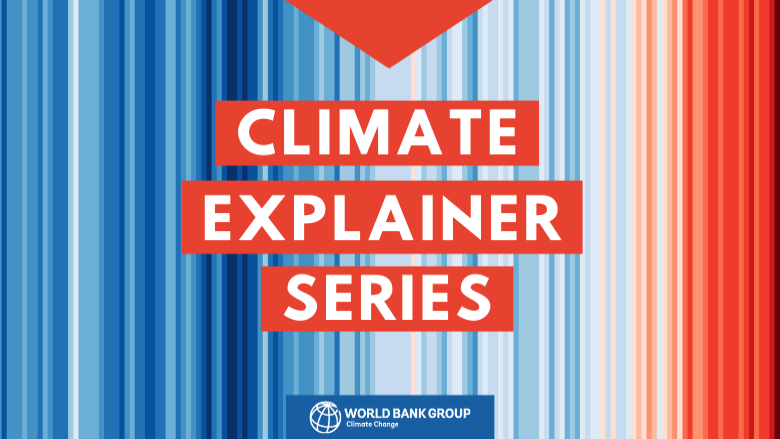From Bangladesh to Mozambique, countries around the world face the accelerating impacts of climate change. Research has found that the poorest people least responsible for rising CO2 emissions are often the most exposed to climate risk, and that climate change could push up to 132 million people into extreme poverty by 2030.
Severe rainfall can cause mudslides, road washouts, and floods that can contaminate water supplies. Higher temperatures can reduce the efficiency of electricity transmission and distribution, as well as place stress on grid networks from increased cooling demands. Droughts can harm livestock and crop productivity, while changes in rainfall patterns can increase the risk of crop pest infestations and threaten food security.
In this context, the World Bank Group set a target to increase climate finance to 28% of lending and to systematically factor climate change into projects. This commitment was underpinned by the Group’s first Climate Change Action Plan. As a result, from 2016-2020 the Bank Group provided over $83 billion to developing countries to mitigate greenhouse gas emissions and help people adapt. By 2020, financing for climate change adaptation had risen from 40% of the Bank’s climate finance to more than 50%, driven by the boost in financing and strong demand in developing countries.
In 2019, the Bank launched the Action Plan on Climate Change Adaptation and Resilience to further support countries’ efforts to adapt and manage climate risk and to build resilience -- the capacity to prepare for disruptions, recover from shocks, and grow from a disruptive experience.
The plan included the development of a new rating system to improve tracking of global progress on adaptation and resilience and to create incentives to engage in more and better adaptation. In January 2021, the Resilience Rating System was being piloted in more than 20 World Bank projects across all regions, covering sectors in human development, infrastructure, and sustainable development.
The new rating system provides guidance on developing climate-resilient projects and a way to assess what projects are doing to increase climate resilience. The system evaluates two dimensions of resilience, each one rated from C to A+: the resilience of the project design – the project’s ability to withstand impacts from climate and disasters -- as well as how people are being made more resilient through the project itself.
In this interview, World Bank Climate Change Lead Economist Stéphane Hallegatte explains how the Resilience Rating System will improve development projects and help countries adapt to climate change.
What is the history behind the Resilience Rating System and what problem is it solving?
Monitoring and evaluation of projects have always been part of our work. As we increased our climate financing over the last five years, we introduced a new way of measuring how much of our lending had climate “co-benefits.” But, very quickly, people started to feel that this metric told only part of the story.
One of the big gaps in the metric we currently use is that it aggregates the efforts to make all projects more resilient, what we often call mainstreaming, and the efforts dedicated to improving resilience and supporting adaptation. The Resilience Rating System was designed to capture these two dimensions independently to better monitor and pilot our portfolio and better report on what we are doing.
Another problem that the Resilience Rating helps to solve, is the challenge of monetizing climate interventions. For example, interventions that affect policy change and strategic systems-level planning to increase incentives for climate action may not be reflected in a high financial sum, compared to a large infrastructure project, but could potentially be transformative. The resilience rating system helps recognize these types of projects.
Right now, you can find projects doing a great job in terms of resilience. But because the methodology is very technical (people don't always read the third Appendix to the technical documentation of the project), decision-makers or investors may not be able to identify those projects and give them priority over other, less-resilient, projects. We hope that by making a project rating understandable to the non-expert, with just one letter – such as an A or a B or a C -- it will be easier to see when a team is doing a good job. And I'm not just talking about project teams at the World Bank, but also outside. Good projects will get more visibility, teams will get more rewards for their efforts, and therefore have stronger incentives to do it.
I think the key is, we started from a measurement problem, and in trying to solve that problem, we have created more than just a monitoring system. We created guidance and tools that people can use to design better development projects and we are also generating incentives by making the good job done by the teams more visible.
How does it work? Is it easy to use? How will it change the way projects are designed and implemented?
A key thing to note is, when we were developing this tool, we found some World Bank projects that would be rated A+ using this metric. So, the highest rating is not some crazy, idealistic level of perfection. There are existing examples of best-in-class projects from the perspective of resilience. The challenge is to bring all projects to the same level.
In the piloting of this tool, we are working with a little more than 20 projects that are being designed. Rather than arriving at the end of the project development process and putting a rating on those projects, we are working with the teams to get projects to a high rating, A or A+ in one or the two dimensions: the resilience of the project’s design (whether it is resilient to risks from climate change and natural hazards); and the resilience gained through project outcomes (whether it builds the resilience of people and of the wider system). We want the piloting to show not only that the rating system can provide visibility, but also become actionable guidance that teams can use to build better projects.
There are things that teams should do to get a good rating, and those things happen at different stages. The concept note stage is when you want to screen the threats that a project might be exposed to and also explore the opportunities to build the resilience of project beneficiaries. A lot of the projects in the pilot are at the stage of project design when you try to transform the information gained from risk screening and exploration of resilience opportunities into actual components of the project. For example, if screening reveals there is a big flood risk, then you probably need to include a flood risk management component in the project. If your exploration of resilience opportunities suggests that you can make the population more resilient by building small scale drainage in a slum, then you will want to add this drainage component in the project preparation phase.
To get the highest rating under the Resilience Rating System, you need to show in the project appraisal and in the economic and financial analysis of the project that climate risks do not threaten the viability of the project. You also have to explain how the project is building the resilience of the population, which means explaining what the population is vulnerable to and how people will be less vulnerable after your project has been completed. If the project documents all of that, then it can get a high rating. That is our objective in the pilot. If it works, the goal is to do that for all our projects.


